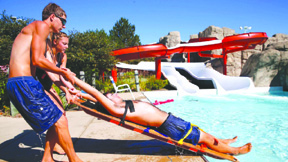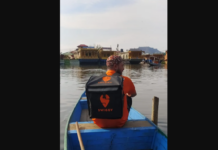
YPSILANTI TOWNSHIP, Mich.: With their appealing slides and wave pools, waterparks are increasingly popular places to spend a summer day. But the shallow waters belie hazards that experts say visitors who are focused on the fun may be underestimating.
As the parks proliferate, concern is growing about the risks present even when most of the water is shallower than 3 feet (1 meter) -people who aren’t good swimmers mixed with the unexpected hit of waves and falls that can lead to concussions or even drownings. The American Red Cross, a leading trainer of lifeguards, has taken note and added training for extreme shallow water rescues.
“We pretty much have an ambulance call every weekend,” said Brian Machemer, superintendent of the Rolling Hills Water Park in Ypsilanti Township. He added, “On average, we probably have a pull-out a day. Now, that isn’t always a serious incident. But it’s somebody who’s struggling that we feel we need to help out.”
While no figures are available for overall waterpark injuries, the Red Cross cited U.S. Consumer Product Safety Commission estimates. Those show about 4,200 people a year taken to emergency rooms to be treated for scrapes, concussions, broken limbs, spinal injuries and other such injuries suffered on public waterslides. Those numbers, though, do not include other waterpark injuries or those who need lifeguard assistance without a hospital trip.
“You’re in an environment that is extreme fun but can be extremely dangerous if you’re not vigilant,” said Roy Fielding, a senior lecturer at the University of North Carolina-Charlotte and a specialist in life guarding and water safety who is on the Red Cross Scientific Advisory Council.
In July alone, one drowning and at least three near-drownings were reported at U.S. waterparks. A 5-year-old girl drowned in a shallow area of a wave pool at a municipal-owned waterpark in Grand Island, Nebraska. The wave pool was not operating at the time.
Two of the near-drownings involved children in Missouri and California at municipal-run waterparks – a growing segment of the industry as cities and counties look to boost revenue from what their flat-water pools deliver. The other was at a corporate-owned waterpark in Utah. The Missouri incident involved a 6-year-old girl who hit her head on the bottom of a kiddie pool. The other two occurred in wave pools, which are shallow at the entrance but usually slope to at least 5 feet deep.
“One of the things that can happen is in our wave pool people aren’t used to being hit by waves of water,” Machemer said. Things like getting water in the mouth and swallowing, he said, “can set off a panic reaction.” -AP






